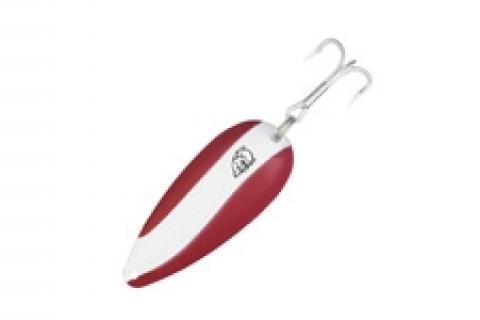
Lou Eppinger was a taxidermist practicing his artistry in Detroit in the late 19tth Century, but work was uneven, so he began selling fishing lures to flesh out his income. He eventually tried experimenting and creating some himself, crafting them out of metal.
 |
| Eppinger's most famous lure, the Dardevle, was named after Marines, who were called Dare Devils for their feats in World War I. |
In 1906, while on a camping trip in Ontario, he gave one of his new inventions a try on a lake. Not only did it cast farther than any other artificial in his tackle box, it caught more fish and bigger ones.
Little did the taxidermist know he had created a lure that would still be catching fish a century later. Eppinger continued tinkering with the spoon, testing it and improving it. In 1912, he finally perfected the design that allowed his lure to be cast accurately even in the teeth of a strong wind and wobble tantalizingly on the retrieve. He named the new offering the Osprey and began marketing it.
In 1918, Eppinger renamed the spoon after the Marines, who had been called "Dare Devils" for their feats in World War I. Later he changed the spelling to Dardevle, to avoid controversy. Ed Eppinger, Lou's nephew, soon joined the firm and over the years it grew into one of the largest tackle businesses in the country. Eppinger now offers a wide variety of spoons and spinners, besides the famous red and white Dardevle, in a myriad of color combinations. You can buy them small enough to catch anything from a 10-inch native brook trout in a tiny stream to stripers in lakes to huge muskies and giant lake trout in northern Canada.
Tactics
Try a moderate to fast steady retrieve either casting or trolling and you can't go wrong. Also experiment by jerking the lure, then letting it flutter down. Another method I like calls for reeling fast over shallow water and then simply stopping the retrieve when you come to a deep dropoff. Fish will strike the lure as it flutters down.
If fish are deep, simply jig the Dardevle up and down vertically beneath the boat. This is also a productive method through the ice on frozen northern waters during winter. Using downriggers to take the spoon deep and side-planers to pull them away from the noise of the boat are deadly methods on the Great Lakes and other large bodies of water with trout and salmon.
These lures are classics for pike, muskies, pickerel, lakers, stripers, arctic char, cutthroats, browns, rainbows and walleyes. In small sizes they are also deadly on smallmouths in rivers, panfish in ponds and brook trout in small mountain streams.
The Dardevle has definitely stood the test of time.
- 7880 views

